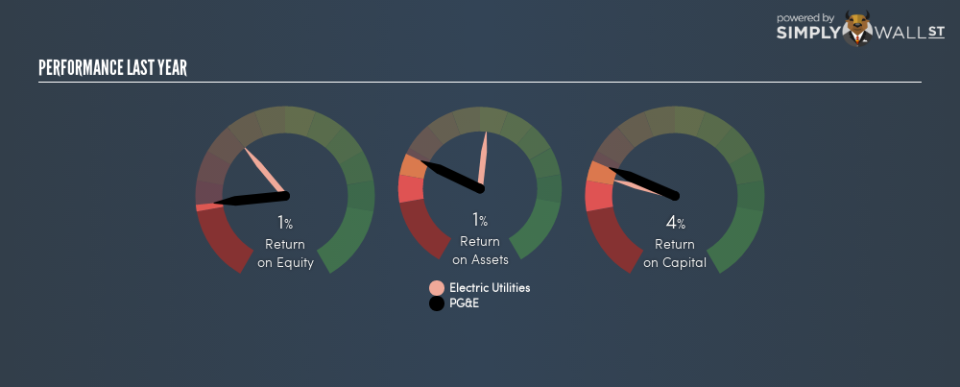Why You Should Care About PG&E Corporation’s (NYSE:PCG) Low Return On Capital

Today we are going to look at PG&E Corporation (NYSE:PCG) to see whether it might be an attractive investment prospect. In particular, we’ll consider its Return On Capital Employed (ROCE), as that can give us insight into how profitably the company is able to employ capital in its business.
Firstly, we’ll go over how we calculate ROCE. Second, we’ll look at its ROCE compared to similar companies. And finally, we’ll look at how its current liabilities are impacting its ROCE.
Return On Capital Employed (ROCE): What is it?
ROCE is a measure of a company’s yearly pre-tax profit (its return), relative to the capital employed in the business. All else being equal, a better business will have a higher ROCE. Overall, it is a valuable metric that has its flaws. Author Edwin Whiting says to be careful when comparing the ROCE of different businesses, since ‘No two businesses are exactly alike.’
How Do You Calculate Return On Capital Employed?
The formula for calculating the return on capital employed is:
Return on Capital Employed = Earnings Before Interest and Tax (EBIT) ÷ (Total Assets – Current Liabilities)
Or for PG&E:
0.04 = US$3.0b ÷ (US$71b – US$9.5b) (Based on the trailing twelve months to September 2018.)
So, PG&E has an ROCE of 4.0%.
See our latest analysis for PG&E
Want to help shape the future of investing tools and platforms? Take the survey and be part of one of the most advanced studies of stock market investors to date.
Is PG&E’s ROCE Good?
One way to assess ROCE is to compare similar companies. Using our data, PG&E’s ROCE appears to be significantly below the 5.1% average in the Electric Utilities industry. This could be seen as a negative, as it suggests some competitors may be employing their capital more efficiently. Regardless of how PG&E stacks up against its industry, its ROCE in absolute terms is quite low (especially compared to a bank account). There are potentially more appealing investments elsewhere.
In our analysis, PG&E’s ROCE appears to be 4.0%, compared to 3 years ago, when its ROCE was 2.9%. This makes us think about whether the company has been reinvesting shrewdly.
It is important to remember that ROCE shows past performance, and is not necessarily predictive. Companies in cyclical industries can be difficult to understand using ROCE, as returns typically look high during boom times, and low during busts. ROCE is, after all, simply a snap shot of a single year. What happens in the future is pretty important for investors, so we have prepared a free report on analyst forecasts for PG&E.
How PG&E’s Current Liabilities Impact Its ROCE
Liabilities, such as supplier bills and bank overdrafts, are referred to as current liabilities if they need to be paid within 12 months. The ROCE equation subtracts current liabilities from capital employed, so a company with a lot of current liabilities appears to have less capital employed, and a higher ROCE than otherwise. To counter this, investors can check if a company has high current liabilities relative to total assets.
PG&E has total assets of US$71b and current liabilities of US$9.5b. Therefore its current liabilities are equivalent to approximately 13% of its total assets. With a very reasonable level of current liabilities, so the impact on ROCE is fairly minimal.
The Bottom Line On PG&E’s ROCE
PG&E has a poor ROCE, and there may be better investment prospects out there. Of course you might be able to find a better stock than PG&E. So you may wish to see this free collection of other companies that have grown earnings strongly.
I will like PG&E better if I see some big insider buys. While we wait, check out this free list of growing companies with considerable, recent, insider buying.
To help readers see past the short term volatility of the financial market, we aim to bring you a long-term focused research analysis purely driven by fundamental data. Note that our analysis does not factor in the latest price-sensitive company announcements.
The author is an independent contributor and at the time of publication had no position in the stocks mentioned. For errors that warrant correction please contact the editor at editorial-team@simplywallst.com.


